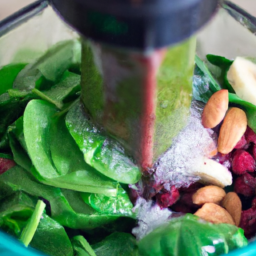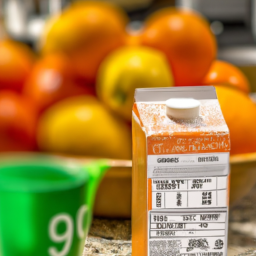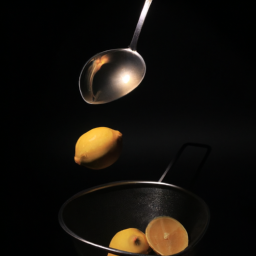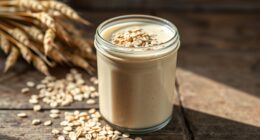For a long time, I have believed that the real joy of making a pot roast comes from the delicious juices left in the pan afterwards. I have spent years trying to find the perfect way to turn these juices into a rich and flavorful gravy. After many experiments, I am excited to finally share my recipe with you.
Making gravy with pot roast juice is a great way to elevate your meal and add a depth of flavor that can’t be achieved with store-bought gravy. It’s also a great way to avoid wasting any of the delicious juices left over from cooking your roast.
So, let’s get started and learn how to turn that pot roast juice into a delicious gravy that will have your dinner guests coming back for seconds!
Key Takeaways
- Pot roast juice is a versatile ingredient that can be used to make gravy, soups, stews, and sauces.
- Flour or cornstarch can be used as a thickening agent for gravy, and seasonings like thyme, rosemary, sage, garlic, and onion powder can be added.
- Roux requires equal parts fat and flour, with butter being a common choice for the fat, and must be cooked gradually while stirring constantly.
- Tasting and adjusting the flavors of the gravy is crucial, and straining it is necessary to achieve a smooth texture and remove lumps or chunks.
Collect the Pot Roast Juice
Don’t let that delicious pot roast juice go to waste – collect it and use it to create a mouth-watering gravy that will elevate your meal to the next level.
After removing the pot roast from the cooking vessel, carefully pour the juice into a heatproof container, making sure to scrape all the flavorful bits from the bottom of the pan.
Using pot roast juice for other recipes is a fantastic way to add depth and complexity to your dishes, so don’t discard it!
If you don’t plan on using the pot roast juice immediately, store it in an airtight container in the refrigerator for up to three days.
You can also freeze the juice for later use. Simply pour it into a freezer-safe container and store it for up to three months. When you’re ready to use it, thaw it out in the refrigerator overnight.
Now that you have your pot roast juice collected, it’s time to prepare the ingredients for the gravy.
Prepare the Ingredients
When it comes to making gravy with pot roast juice, two important factors to consider are the thickening agent and the seasonings. Personally, I like to use flour as my thickening agent, but some prefer cornstarch. It really depends on your preference and dietary needs.
As for seasoning, I usually go for a blend of herbs like thyme, rosemary, and sage, but you can also add in garlic or onion powder for extra flavor. It’s all about finding the right balance to make the perfect gravy for your pot roast.
Flour or Cornstarch for Thickening
Using flour or cornstarch is a great way to thicken up the delicious pot roast juice for a tasty gravy. Both have their pros and cons, so it’s important to consider what you’re looking for in your gravy.
Flour is a common choice for thickening gravy because it’s readily available and easy to use. However, it can make your gravy cloudy and leave a bit of a floury taste. Cornstarch, on the other hand, creates a clear, glossy sauce and doesn’t affect the taste as much. However, it can be a bit trickier to use and may not hold up as well if reheated. If you’re looking for an alternative to these options, arrowroot powder or potato starch can also be used for thickening.
When choosing between flour and cornstarch, it ultimately comes down to personal preference and what you’re looking for in your gravy. Once you’ve made your decision, it’s time to move on to the next step: choosing the right seasonings.
Choosing the Right Seasonings
To really elevate the flavor of your homemade gravy, you’ll want to choose the right seasonings. This is where you can get creative and experiment with different flavor profiles and spice blends. Here are three items to consider when choosing your seasonings:
-
Consider the flavor profile of your pot roast. Is it a classic beef roast with herbs like thyme and rosemary? Or is it a spicy Mexican-style roast with chili powder and cumin? Choose seasonings that complement the flavors already present in your pot roast.
-
Don’t be afraid to mix spice blends. For example, a blend of garlic powder, onion powder, and paprika can add a delicious savory flavor to your gravy. Or try mixing different types of dried herbs, such as sage and parsley, for an earthy flavor.
-
Taste as you go. Add seasonings gradually and taste frequently to ensure that the gravy is balanced and not overpowering. Remember, you can always add more, but it’s difficult to take away.
Now that we’ve chosen our seasonings, it’s time to make a roux to thicken the gravy.
Make a Roux
So, now that I’ve got the pot roast juice, it’s time to make the roux for the gravy.
The first thing I need to keep in mind is that the roux requires equal parts fat and flour. I like to use butter for the fat, as it adds a nice richness to the gravy.
Once I have my ingredients measured out, I’ll cook the roux over medium heat, stirring constantly, until it reaches a golden brown color.
Equal Parts Fat and Flour
Hey, you wanna make sure you’ve got an even amount of grease and flour when you’re whisking up that gravy from your pot roast juice. This is because the amount of fat and flour you use will ultimately determine the thickness and texture of your gravy.
If you use too little flour, your gravy will be thin and runny. On the other hand, if you use too much flour, your gravy will be thick and clumpy.
When it comes to choosing your fat, you have a few different options. You can use the grease from your pot roast, butter, or even oil. The key is to use an equal amount of fat and flour so that your roux is balanced.
If you’re looking for alternative thickeners, you can also use cornstarch or arrowroot powder. Just keep in mind that these thickeners can result in a slightly different texture than a traditional roux.
With the right balance of fat and flour, you’ll be well on your way to delicious pot roast gravy. Now, let’s move onto cooking the roux.
Cooking the Roux
Now that we’ve got equal parts of fat and flour, it’s time to cook the roux. I usually use a cast-iron skillet for this step. It’s important to keep stirring and not walk away from the pan, or the mixture will burn.
Here are some tips for cooking the roux:
- Start with low heat and gradually increase it as the roux begins to darken.
- Cook the roux until it reaches a deep brown color, similar to the color of a penny.
- Remember that the longer you cook the roux, the darker and more flavorful it will become.
If you’re feeling adventurous, you can also experiment with different roux alternatives, such as using bacon fat or butter instead of oil. This will add a unique flavor to your gravy. Additionally, you can add seasonings to the roux, such as garlic or onion powder, to enhance the flavor even more.
Now that we have our roux cooked to perfection, it’s time to add the pot roast juice.
Add the Pot Roast Juice
After removing the pot roast from the pan, pour the juice into a fat separator to make it easier to remove any excess fat. Don’t throw away the pot roast juice because it has many uses. You can use it as a base for soups, stews, and sauces. It’s also a great alternative to beef broth or stock in recipes that require it.
If you’re not planning to use it right away, store it in an airtight container and freeze it for later use. Once you’ve separated the fat from the pot roast juice, pour it back into the pan and heat it over medium heat. Gradually whisk in the roux until it’s smooth and well combined. Keep whisking for a few minutes until the mixture thickens and turns golden brown.
Then, lower the heat and slowly pour in the pot roast juice, whisking constantly to prevent lumps from forming. Bring the mixture to a simmer and cook it for a few minutes until it thickens to your desired consistency.
Whisk and Simmer
To thicken the sauce, you’ll need to whisk in the roux until it’s smooth and combined, then simmer the mixture until it thickens to your liking, like a chef stirring a cauldron of magic.
When whisking in the roux, it’s important to use proper techniques to avoid clumps and achieve a smooth consistency. Start by adding a small amount of roux to the pot roast juice and whisk it vigorously until it’s fully incorporated into the liquid. Then, gradually add more roux while whisking constantly until the mixture is thick and smooth.
Once you’ve achieved the desired consistency, it’s time to let the mixture simmer. The length of time needed to thicken the sauce will depend on how much liquid you’re working with and how thick you want the final product to be. Generally, simmering for 10-15 minutes should be sufficient, but you can continue to simmer for longer if you want a thicker sauce.
As the mixture simmers, stir it occasionally with a whisk to prevent it from sticking to the bottom of the pan. Once the sauce has thickened to your liking, you can move on to adjusting the seasonings.
With the sauce thickened and simmered to perfection, it’s time to adjust the seasonings to taste.
Adjust Seasonings
Once the sauce has thickened, it’s important to taste and adjust the seasonings. This step is crucial to creating a truly delicious and well-balanced gravy.
Start by taking a small spoonful of the sauce and tasting it. Pay attention to the flavors and note which ones are more dominant. Is the gravy too salty? Too sweet? Too acidic? If so, it’s time to start adjusting the seasonings.
To adjust the flavors, start by adding small amounts of salt, sugar, or acid as needed. Remember, it’s always better to start with a small amount and add more gradually than to add too much and ruin the whole batch. Keep tasting and adjusting until the gravy is just right.
Once you’re happy with the flavors, you’re ready to move on to the next step: straining the gravy.
Strain the Gravy
Now it’s time to pour the rich, flavorful sauce through a fine mesh strainer to achieve a smooth, velvety texture. Straining the gravy is an important step that ensures a perfect consistency and removes any lumps or chunks that may have formed during the cooking process.
You can use a regular strainer, but I prefer to use a fine mesh strainer as it captures even the tiniest bits and pieces. When straining the gravy, it’s important to do it in small batches, allowing the liquid to pass through the strainer on its own without pressing or forcing it through. This helps to prevent any bits or lumps from making their way through the strainer and into the gravy.
The straining technique also helps to enhance the flavor profile of the gravy, creating a smooth, silky texture that perfectly complements your main dish. Now that the gravy is strained and smooth, it’s time to serve and store it.
Serve and Store
After straining, you’ll want to transfer the smooth sauce to a gravy boat or serving dish for easy pouring over your meal. Make sure to use a ladle to avoid spilling the hot liquid.
If you’re feeling creative, you can serve the gravy in individual ramekins or small bowls for each guest to have their own portion. You can also add some garnish like chopped parsley or thyme on top for a pop of color and added flavor.
If you have leftover gravy, make sure to store it properly in an airtight container in the fridge. It’ll keep for up to 3 days.
When reheating, make sure to do so slowly and gently on the stovetop or in the microwave, stirring frequently to prevent any lumps from forming. And if you don’t have any pot roast juice left, don’t worry! There are plenty of variations and substitutions you can use to make delicious gravy, which we’ll cover in the next section.
Variations and Substitutions
As you delve deeper into the world of sauces, you’ll discover a plethora of variations and substitutions that can be used to elevate your dishes to the next level. Here are some ingredient substitutions and flavor variations that I’ve personally tried and recommend:
- Instead of using all-purpose flour, try using cornstarch or arrowroot powder as a thickening agent for a gluten-free option.
- Add some red wine or balsamic vinegar for a tangy and acidic note to balance out the richness of the gravy.
- For a smoky flavor, add a dash of liquid smoke or smoked paprika to the gravy.
- Use beef broth or vegetable broth instead of water to enhance the depth of flavor.
- Add some herbs such as thyme, rosemary, or sage for a savory and aromatic touch.
By experimenting with different ingredients and flavor combinations, you can customize your gravy to your liking and make it stand out from the usual.
Now, let’s move on to some troubleshooting tips to ensure that your gravy comes out perfectly every time.
Troubleshooting Tips
If you’re finding yourself with a lumpy sauce, don’t panic – simply strain it through a fine mesh sieve or blend it with an immersion blender until it’s smooth and velvety. This is a common mistake that can easily be fixed.
Another common mistake is not allowing enough time for the flavors to meld together. It’s important to let the sauce simmer for at least 10-15 minutes to really allow the flavors to develop.
To enhance the flavor of your gravy, consider adding a splash of red wine or a sprinkle of fresh herbs like thyme or rosemary. You can also experiment with different types of broth or stock to give your gravy a unique taste.
Remember that gravy is all about balance – you want it to be flavorful but not overpowering, and thick but not too thick. With a little practice and experimentation, you’ll be able to make the perfect gravy every time.
Frequently Asked Questions
Can I use the pot roast juice from a different recipe for this gravy?
Yes, you can use pot roast juice from a different recipe for gravy. However, if the consistency is not thick enough, you can use alternative thickening agents for the roux such as cornstarch or flour.
What can I do if I don’t have all the ingredients for the roux?
Substitute ingredients in the roux if needed. For flour, try cornstarch or arrowroot. For butter, use oil or margarine. Alternative techniques include using a slurry of flour and cold water or using a reduction of the pot roast juice.
Can I use a different type of flour for the roux?
Yes, alternative flours can be used for the roux. Roux substitutes include cornstarch and arrowroot. However, the taste and texture may differ. Experiment to find a substitute that works for you.
How long should I simmer the gravy for?
To achieve optimal flavor, simmer time is crucial when making gravy. I recommend simmering for at least 10-15 minutes, or until the desired consistency is reached. Adding flavor enhancers such as herbs or spices can also enhance the taste.
Can I freeze the gravy for later use?
Yes, you can freeze the gravy for later use. Let it cool down completely, then transfer it to an airtight container. Label it with the date and freeze it for up to 3 months. To reheat, thaw it overnight in the fridge and then reheat it on the stove or in the microwave, stirring occasionally.
Conclusion
And that’s how I make gravy with pot roast juice! It’s a simple process that yields a delicious result.
One interesting statistic to note is that, according to a survey conducted by the National Turkey Federation, 60% of Americans prefer gravy on their turkey during Thanksgiving.
Gravy is a staple in many households and can be used to enhance the flavor of any dish. Don’t be afraid to experiment with different variations and substitutions to make it your own.
With a little practice, you’ll be making perfect gravy every time. Happy cooking!
Ilana has been a vegan for over 10 years. She originally made the switch for health reasons, but soon found herself becoming more and more passionate about the ethical and environmental implications of a vegan lifestyle. Ilana is the author of The Graceful Kitchen, a blog all about veganism. She loves to cook up delicious and nutritious vegan meals, and share her recipes with others who are interested in leading a cruelty-free life. Ilana is also a strong advocate for using whole foods as the foundation of a healthy diet, and believes that going vegan is one of the best ways to achieve this.










